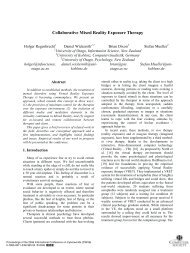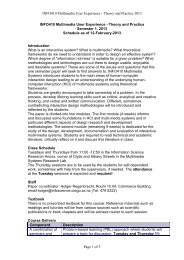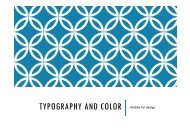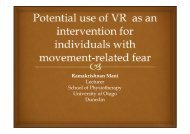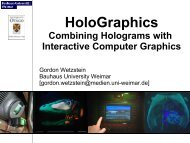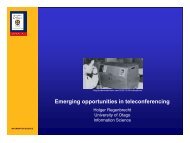Smart-phone augmented reality for public participation in urban ...
Smart-phone augmented reality for public participation in urban ...
Smart-phone augmented reality for public participation in urban ...
Create successful ePaper yourself
Turn your PDF publications into a flip-book with our unique Google optimized e-Paper software.
group response was very positive (median=6, m<strong>in</strong>=5),<br />
whereas the median response from the 26-plus age group<br />
was 2.5 po<strong>in</strong>ts lower (median=4.5), and the m<strong>in</strong>imum<br />
value was lower still (m<strong>in</strong>=2).<br />
Figure 7. Perceived system ease of use.<br />
The feedback provided some <strong>in</strong>sight <strong>in</strong>to these responses.<br />
One user of the 26-plus age group found the screen to be<br />
too small to use com<strong>for</strong>tably, and one person found the<br />
buttons <strong>for</strong> vot<strong>in</strong>g to be too small. Most people found the<br />
system easy to use because of its simplicity.<br />
System Utility<br />
Figure 8 shows the participants' responses when asked to<br />
what degree they considered the system useful <strong>for</strong><br />
participat<strong>in</strong>g <strong>in</strong> the <strong>urban</strong> plann<strong>in</strong>g project. The results to<br />
this question were more similar between age groups than<br />
<strong>in</strong> previous questions. This could suggest that it did not<br />
require a high level of familiarity of the technology to<br />
understand the systems purpose and consider its potential<br />
utility.<br />
Figure 8. Perceived system utility<br />
Accord<strong>in</strong>g to their feedback, participants thought that the<br />
17<br />
system was a useful visual aid which would motivate<br />
people to get <strong>in</strong>volved <strong>in</strong> the plann<strong>in</strong>g process, and that it<br />
was good to have an actual perspective of how the<br />
designs would look. One participant noted that it would<br />
remove the shyness that people often experience <strong>in</strong> <strong>public</strong><br />
meet<strong>in</strong>gs (dur<strong>in</strong>g traditional plann<strong>in</strong>g events), and that<br />
everyone could participate. It was suggested that “multivot<strong>in</strong>g”<br />
would need to be controlled, and that it should<br />
have been available <strong>for</strong> previous plann<strong>in</strong>g processes.<br />
Augmented Reality Architecture<br />
Participants were asked how useful they found it to see<br />
the new architectural designs superimposed <strong>in</strong> their actual<br />
environmental context. Aga<strong>in</strong>, the response was very<br />
positive and relatively even across the age groups. The<br />
box plot of the results can be seen <strong>in</strong> Figure 9. Both the<br />
overall response and the 18-25 group showed a median of<br />
7, and no response was lower than 4 on the 7-po<strong>in</strong>t scale.<br />
Figure 9. Perceived usefulness of see<strong>in</strong>g architectural<br />
designs <strong>in</strong> their environmental context<br />
Participants found the <strong>augmented</strong> <strong>reality</strong> visualisations<br />
useful <strong>for</strong> a variety of reasons. It was suggested that it<br />
would help people visualise the <strong>in</strong>tention of the design<br />
better than if they only had access to drawn plans, and<br />
that it was good to see a real life model of how the<br />
proposed build<strong>in</strong>gs would look. One respondent noted<br />
that they were unfamiliar with other methods of <strong>public</strong><br />
<strong>in</strong>volvement <strong>in</strong> the design process, so was unsure how<br />
these visualisations would compare to more traditional<br />
methods. Some participants would have liked a better<br />
view of the build<strong>in</strong>g and the overlaid model (a<br />
shortcom<strong>in</strong>g of the panorama track<strong>in</strong>g technique that was<br />
to be expected), and one would have liked more realistic<br />
models to fully understand how they would look <strong>in</strong> the<br />
context of the street.<br />
Perceived Participation<br />
Only two participants had participated <strong>in</strong> previous <strong>urban</strong><br />
plann<strong>in</strong>g events, mak<strong>in</strong>g it difficult to gauge any shift <strong>in</strong><br />
<strong>public</strong> response <strong>in</strong> terms of perceived <strong>participation</strong>.<br />
Figure 10 shows the results of the question which asked<br />
participants whether they felt that their feedback (<strong>in</strong> the



